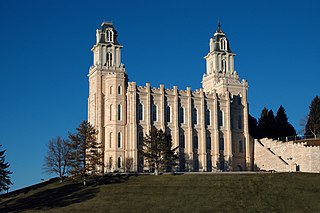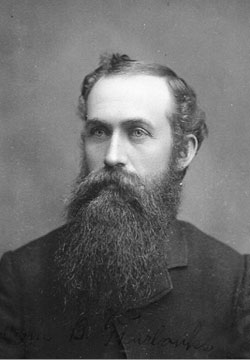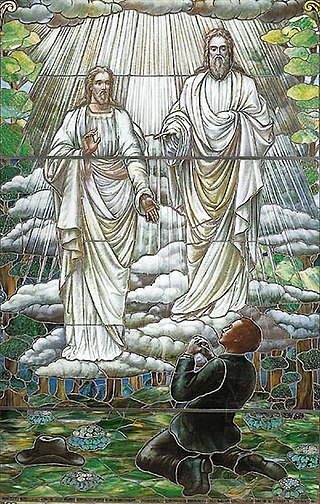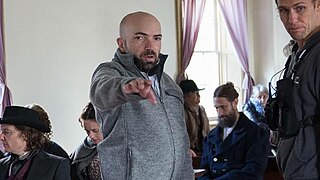James C. Christensen was an American illustrator and painter of religious and fantasy art.

The Manti Utah Temple is the fifth constructed temple of the Church of Jesus Christ of Latter-day Saints. The temple construction was completed in 1888. Located in the city of Manti, Utah, it was the third Latter-day Saint temple built west of the Mississippi River, after the Mormon pioneers trekked west. The Manti Temple was designed by William Harrison Folsom, who moved to Manti while the temple was under construction. The temple dominates the Sanpete Valley and can be seen from many miles. Like all Latter-day Saint temples, only church members in good standing may enter. It was previously one of only two remaining Latter-day Saint temples in the world where live portrayal was used in the endowment ceremony. All other temples use a film in the presentation of the endowment, a practice that will also be used in Manti beginning in 2024 following renovation. It is an early pioneering example of four rooms representing the journey of life.

Arnold Friberg was an American illustrator and painter noted for his religious and patriotic works. He is perhaps best known for his 1975 painting The Prayer at Valley Forge, a depiction of George Washington praying at Valley Forge. He is also well known for his 15 "pre-visualization" paintings for the Cecil B. DeMille film The Ten Commandments which were used to promote the film worldwide and for which he received an Academy Award nomination.

Minerva Bernetta Kohlhepp Teichert was a 20th-century American artist who painted Western and Mormon subjects, including murals of scenes from the Book of Mormon. She received her art education from the Art Institute of Chicago and the Art Students League of New York, and was a member of the Church of Jesus Christ of Latter-day Saints. Religious-themed artwork by Teichert includes Christ in a Red Robe, Queen Esther, and Rescue of the Lost Lamb. She painted 42 murals related to stories in the Book of Mormon which reside in Brigham Young University's (BYU) Museum of Art. Teichert was the first woman invited to paint a mural for an LDS Church temple.
Fred Emmett Woods IV is a Brigham Young University professor of Latter-day Saint Church History and Mormon Doctrine, an author specializing in Mormon migration and the Globalization of Mormonism.

Avard Tennyson Fairbanks was a 20th-century American sculptor. Over his eighty-year career, he sculpted over 100 public monuments and hundreds of artworks. Fairbanks is known for his religious-themed commissions for the Church of Jesus Christ of Latter-day Saints including the Three Witnesses, Tragedy of Winter Quarters, and several Angel Moroni sculptures on spires of the church's temples. Additionally, Fairbanks sculpted over a dozen Abraham Lincoln-themed sculptures and busts among which the most well-known reside in the U.S. Supreme Court Building and Ford's Theatre Museum.

John B Fairbanks was an American landscape painter. In 1890, he was one of a group of artists who studied in Paris under the sponsorship of the Church of Jesus Christ of Latter-day Saints, in preparation for painting murals at the nearly completed Salt Lake Temple. He painted murals in the Salt Lake Temple and the Mesa Arizona Temple that still exist today. Fairbanks was the official photographer for the South American expeditions of Benjamin Cluff. Fairbanks was the first artist to live and paint in Zion National Park. He was an early art instructor at Brigham Young Academy and was one of the founding members of the Utah Art Institute. Fairbanks was the father of artists John Leo Fairbanks, Ortho Lane Fairbanks and Avard Tennyson Fairbanks (sculptor).
Richard Olsen Cowan is a historian of the Church of Jesus Christ of Latter-day Saints and a former professor in the Church History Department of Brigham Young University (BYU). He was one of the longest-serving BYU faculty and the longest-serving member of the Church History Department ever.
Richard Eyring "Rick" Turley Jr. is an American historian and genealogist. He previously served as both an Assistant Church Historian of the Church of Jesus Christ of Latter-day Saints and as managing director of the church's public affairs department.
Delwin Oliver "Del" Parson is an American painter who is well known for his Latter-day Saint-themed paintings. His painting of Jesus, "Christ in Red Robe," is recognizable from its wide use by the Church of Jesus Christ of Latter-day Saints.
Franz Mark Johansen was a Latter-day Saint sculptor and an emeritus professor at Brigham Young University (BYU). He has been called the founder of the LDS contemporary art movement that expresses spiritual belief through the human form.
Walter Rane is an American painter and illustrator known for book illustrations and religious art.

Mormon art comprises all visual art created to depict the principles and teachings of the Church of Jesus Christ of Latter-day Saints, as well as art deriving from the inspiration of an artist's LDS religious views. Mormon art includes painting, sculpture, quilt work, photography, graphic art, and other mediums, and shares common attributes reflecting Latter-day Saint teachings and values.
Asipeli Havea "Viliami" Tolutaʻu is a Tongan sculptor and an emeritus professor of sculpture at Brigham Young University–Hawaii (BYU–Hawaii).
Liz Lemon Swindle is a painter and artist known for her religious paintings, paintings of Jesus Christ, and works related to the Church of Jesus Christ of Latter-day Saints.

Garrett Batty is an American film director, writer, and producer known for his film The Saratov Approach. He is a graduate of Brigham Young University and a native of Park City, Utah. He is a member of the Church of Jesus Christ of Latter-day Saints, and his films are part of Mormon cinema, but with a more general audience. He has written, directed, and produced four full-length films, including Freetown (2015) and Out of Liberty (2019), and will begin work on a fifth in 2020. For Freetown, he was awarded the 2015 Ghana Movie Award for Best Screenplay alongside Melissa Leilani Larson.
Paige Crosland Anderson is an abstract painter from the United States.
Kathleen Peterson is a painter and illustrator from the United States.

James Goldberg is an American historian, playwright, poet, and writer. He has Jewish, European, and Punjabi ancestors, and his grandfather, Gurcharan Singh Gill, was the first Sikh to join the Church of Jesus Christ of Latter-day Saints. He attended Otterbein University briefly before transferring to Brigham Young University (BYU), where he completed his undergraduate work and earned a Master of Fine Arts degree. He was an adjunct professor at BYU.

George Beard was an English-born photographer and artist in Utah. After emigrating from England, Beard spent the majority of his life running the Cooperative Mercantile in the town of Coalville in Summit County, Utah. He also served as a leader in politics and in his church community for the Church of Jesus Christ of Latter-day Saints. He is most well known for his art and photography skills, with his focus being in nature photography and watercolor painting. Many of his glass plate negative photos were donated to Brigham Young University (BYU) soon after his death. His work has been a part of two exhibits at BYU and the Springville Museum of Art in 1975 and 2017, respectively.











